WonderWomen
On this Page
- Group information
- Project Description
- Competitive Analysis
- Weekly Build Updates
- Final Documentation
Group Information
- Team Name: WonderWomen (WW)
- Group Members: Akshita, Eden, Lilo
Project Description (Due 10/13/21)
Description of Team Name: When we spoke to Cynthia about her patients, she shared that many of them feel a lack of control and autonomy after surviving breast cancer and developing lymphedema. Our team name is inspired by the sense of empowerment we hope to bring to survivors by providing a garment that will adapt to them, rather than forcing them into a mold.
Main Point of Contact: Lilo
Meeting Schedule for the Semester: We met Monday (10/10) at 9:15am for our introductory meeting. We plan to meet again in two weeks (date and time TBD).
Project Plan
Before our next meeting, the NYU students will review the resources Cynthia shared and be in touch via email. After this, we plan to commute to New Jersey to see Cynthia at her office. When we have prototypes in development, Cynthia will reach out to patients to see if they would feel comfortable testing the devices.
Overview of Tools and Expertise
- What tools/expertise will you leverage to complete the project?
We are reviewing literature to get a comprehensive understanding of how lymphedema works and what needs must be addressed for effective management of the condition. We have begun gathering compression garments to see what existing products are currently on the market. We are also in the process of researching smart fabrics to see how they can enhance compression garments. - What additional tools/expertise will you need to complete the project?
In addition to speaking with Cynthia about her understanding as a practitioner, it is important for us to read resources by and hear directly from lymphedema patients to understand their individual needs. We also need to further investigate what fabrics are on the market that might suit our needs. We are communicating with a doctor to ask for their input on what solutions exist for lymphedema patients and how the field can be developed with future products. In addition, we are speaking with a wound care nurse to see what problems frequently arise when compression garments are administered incorrectly.
Timeline
10/6 – Started communication with Cynthia through emails and scheduled a meeting
10/13 – Completed First meeting with Cynthia
10/20 – Reviewing resources Cynthia shared and communicating with her asynchronously to address any questions or concerns. Finding articles written by breast cancer patients/survivors who have developed lymphedema to include their perspectives. Gathering a list of materials and existing products we may refer to for competitive analysis for our midterm presentation.
10/27 – Midterm presentation (background on lymphedema, competitive analysis, problems with existing devices, how we hope to bridge the gaps within existing technologies). Second formal meeting with Cynthia this week.
11/3 – Visit Cynthia sometime around this time to procure samples (after Halloween preferably)
11/10 – Gathering information, deciding the shape and sizes, sourcing of materials. If possible, reverse engineer some existing devices to see how they can be altered to become more adaptable.
11/17 – The first prototype (muslin) and feedback from Cynthia and doctor(s).
11/24 – Second Prototype implementing feedback.
12/1 – Visit Cynthia sometime around this time (tentative for user feedback/trials).
12/08 – Third/Final Prototype for Project Presentation with video prepared, if possible.
12/15 – Final Documentation Due (prepare video).
MIDTerm Presentation
Competitive Analysis and Literature Review (Due 10/27/21)
What is commercially available to solve the problem?

-
- General Overview
- Similar to traditional compression garments, but lined with aloe for cooling effect
- Positive for patients who are hormone-positive, menopausal, and experience elevated body temperature as a result
- Hydrating and delicate on skin.
- Problems
- Is not adaptable to swelling and other changes in patient’s body
- Not suitable for patients with aloe allergy
- General Overview
Ready Wrap by Solaris
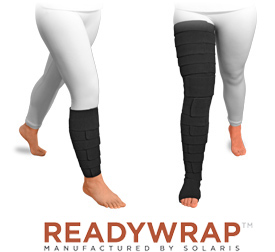
-
- General Overview
- Originally, patients would need to visit a physician 2x/day to receive wrapping compression (Dr. Lerner, 1980s)
- This was good in the sense that the fit of the garment adjusted multiple times a day
- ReadyWrap allows patients to self-adjust the fit of the garment and is less complex than bandaging
- Problems
- Limited adaptability
- Limited input from provider
- General Overview
Kinesio Taping
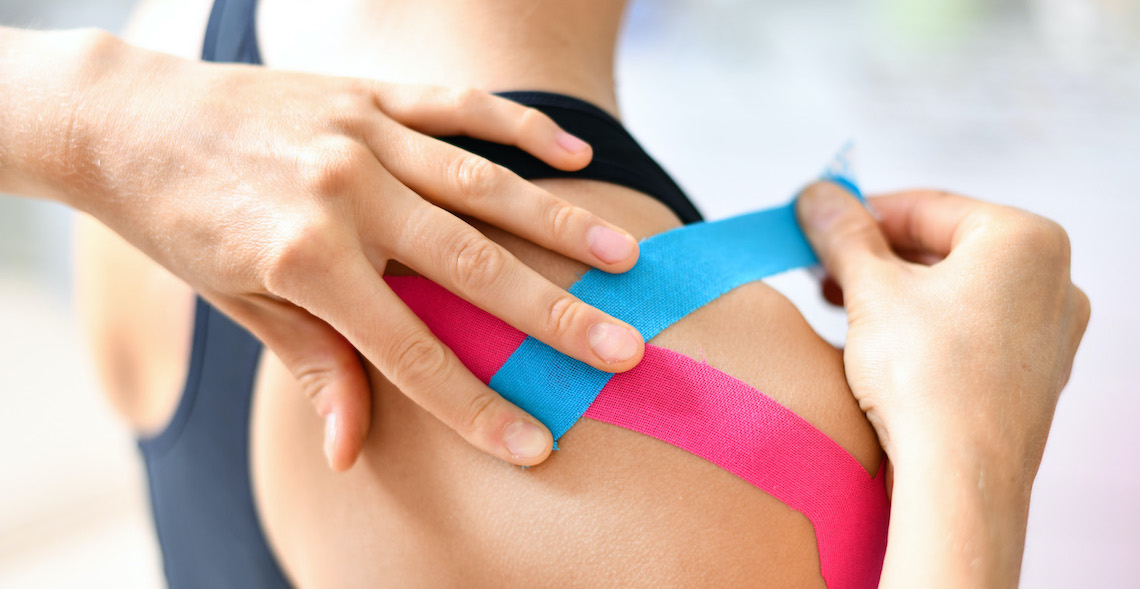
-
- General Overview
- Alternate treatment for lymphedema
- Some studies have shown changes in limb circumference, Shoulder Pain and Disability Index (SPADI) questionnaire, hand grip strength, physical, role, pain, and fatigue score, as well as increased quality of life compared to compression garments
- Low pressure on skin improves lymphatic flow
- Applied by physician 3x/week
- In some cases, patients may learn to self-administer
- Problems
- More conclusive evidence needed regarding its effectiveness
- Risk of patient being uncertain of how to apply
- General Overview
What research has been done in similar domains?
Compression Hosiery in Upper Body Lymphedema
“Template for Upper Body – International Lymphoedema Framework.” Edited by Nicola Rusling, Lympho.org, HealthComm UK Ltd., BSN Medical, 2009, https://www.lympho.org/wp-content/uploads/2016/03/Upper_body.pdf.
- Only one standard compression for upper limb (more exist for lower limbs)
- Kinds of yarn (inlay vs. body) and knitting techniques (flat vs. circular) and pros and cons of each
- Lymphatic drainage
- How to fit lymphedema garment; key points of measurement
Measurement for Ready-to-Wear Garments
“Template for Upper Body – International Lymphoedema Framework.” Edited by Nicola Rusling, Lympho.org, HealthComm UK Ltd., BSN Medical, 2009, https://www.lympho.org/wp-content/uploads/2016/03/Upper_body.pdf.
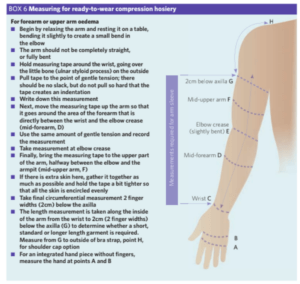
Comparative Study Between the Effects of Kinesio Taping and Pressure Garment
Tantawy, Sayed A., et al. “Comparative Study Between the Effects of Kinesio Taping and Pressure Garment on Secondary Upper Extremity Lymphedema and Quality of Life Following Mastectomy: A Randomized Controlled Trial.” Integrative Cancer Therapies, Jan. 2019, doi:10.1177/1534735419847276.
Kinesio Taping (KT) resulted in changes in limb circumference, Shoulder Pain and Disability Index (SPADI) questionnaire, hand grip strength, physical, role, pain, and fatigue score, as well as increased quality of life, compared to Pressure Garment (PG) group
Effects of Kinesio Taping on Breast-Cancer Related Lymphedema
Kasawara, Karina Tamy. “Effects of Kinesio Taping on Breast Cancer-Related …” ResearchGate.net, Taylor & Francis, Physiotherapy Theory and Practice, 8 Jan. 2018, https://www.researchgate.net/profile/Karina-Kasawara/publication/322317181_Effects_of_Kinesio_Taping_on_breast_cancer-related_lymphedema_A_meta-analysis_in_clinical_trials/links/5a53b62daca2725638c85fde/Effects-of-Kinesio-Taping-on-breast-cancer-related-lymphedema-A-meta-analysis-in-clinical-trials.pdf.
- How KT works (promoting sensory/mechanical stimuli; elastic improves lymphatic flow)
- Benefits: comfort, convenience, hygiene, emotional/quality of life
- Not proven to be most efficient treatment; more evidence needed
Low Intensity Exercise for Breast Cancer Patients with Arm Lymphedema With or Without Compression Sleeve
Johansson K., Tibe K., Weibull A., Newton R.U. Low Intensity Exercise for Breast Cancer Patients with Arm Lymphedema With or Without Compression Sleeve. Lymphology. 2005.
- There is a risk of developing lymphedema in the arms and breast and the return flow in the skin appears in the arm with lymphedema after performing exercises
- Giving movement to the bandage and adjusting self-measurement to allow the woman to follow the arm changes independently in different activities
- Pressure on the arm with a sleeve or bandage still recommended for women with Lymphedema during exercise
Macmillan Cancer Support
Proposed Solution
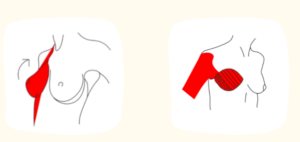
The desired impact is to create a Responsive Design that Adapts to wearer’s body. Secondly, to come up with a comfortable shape that will be the most easy to wear and use as well as give the right amount of pressure needed at the right locations of the body. The garment should be feel as part of the skin/body and soft and breathable. The solution will also not interfere with patients limbs so that they can freely move and use their body. No electronic or magnetic components are proposed at this stage. Hence the garment will not obstruct the use of other devices.
Weekly Build Updates (Starting 11/3/21)
11/17 Update.
Over the past two weeks, we have gathered design inspirations and fabric swatches. We visited Spandex House and B&J to get a sense of possible materials. We realized that we also had to consult existing compression garments and reverse-engineer in order to understand how we could properly use the materials at our disposal.
We have also interviewed a doctor and surgeon who performs lymphedema surgeries on patients, including breast cancer survivors. We will update this blog soon with our findings from the interview (Lilo is currently in the process of translating the questions and answers from Hebrew).
We ordered a special knit lymphedema pressure garment from Amazon in XL size. (Linked here)
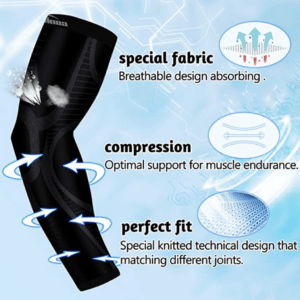
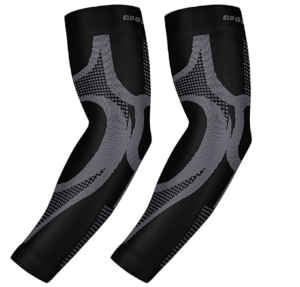
We were interested in the knitting techniques used to create tightness and flexibility in specific areas. Aesthetically, we were attracted to the way the garment resembles athleticwear, in contrast to the somewhat loud patterns offered by lymphediva. The garment also has raised rubber/elastic-like dots (similar to grip socks) at the forearm for grip and pressure.
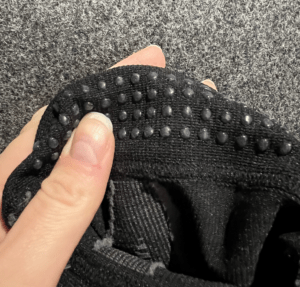
One of us tried the garment on in order to see how it feels on the body. We quickly realized that there may not be enough sizing options offered to adequately account for how different individuals’ proportions may be. The forearm portion of the garment fit a bit too tightly, in a way that seemed like it might cause pooling of fluids in the hand. In contrast, the upper arm section of the garment was too loose despite the inclusion of rubber-like grips, and felt like it would easily slide down. Even though the upper arm was too loose, the wearer associated the rubber components with bras that prevent slippage, which have often been uncomfortable for her.
Also, we feel that there should be something to hold on to from the wrist circumference to keep the garment in place.
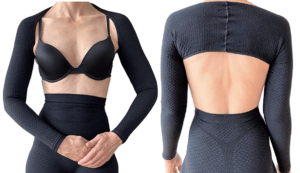
We were also interested in the above design for the solutions it might provide in terms of slippage. However, it occurred to us that not all patients would want to wear something that had two compression sleeves, so we referenced single sleeves that included a strap for fastening, as well.
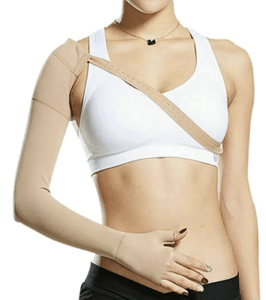
While this design seems stable, we definitely see ways it might be uncomfortable for the wearer, especially after long periods of time. The strap and underarm sections might cut into the skin, which could also present risks for lymphedema patients, given that skincare is a crucial part of managing the condition.
We found commonalities between this lymphedema garment and athletic wear that includes holes for the thumb for stability. For lymphedema patients, this design intends to prevent pooling of fluid in the hands, but we are not sure if this would be effective in all cases.
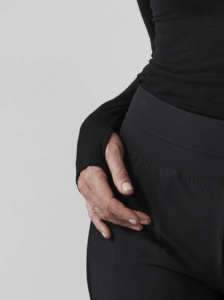
We also wonder if there would be some psychosocial benefits to creating garments that resemble athletic wear, both in terms of comfort for the patient and in terms of how it makes them feel about their condition.
We are also looking into the following options:
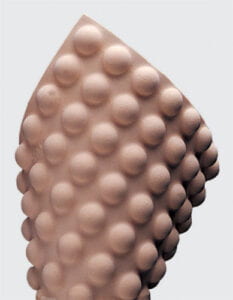
LymphPads feature durable closed-cell foam construction with laminated fabric backing allowing therapists and patients to cut and position the foam without tearing. The unique fabric backing keeps the foam from losing shape with multiple uses and the closed-cell design transmits pressure directly without collapsing or thinning following each use.
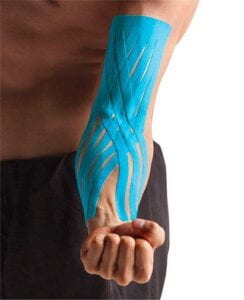
Kinesio Taping – SpiderTech offers a wide variety of precut kinesiology taping products for people with people and muscle pains.
It is important to consult lymphedema patients and not solely base our conclusions on our own judgments. We look forward to meeting with Cynthia on Tuesday, November 30, at her office to gather more information. In the meantime, we plan to meet remotely and send other available products to get a sense of what the pros/cons would be, according to her experience with patients.
Final Presentation
Final Blog
In our research over the last few weeks we found, compression garments and devices are facets of a comprehensive treatment and management plan.
Lymphedema if left untreated can create a lot of complications and hinder the functions of daily life. In our research and talking to Cynthia we realised that a garment alone cannot solve the problem rather it’s a way of life and multi-level steps can help people regain their strength.
• Compression
• Lymphatic massage
• Exercise
• Skincare
• Complex decongestive therapy
• Lymphatic Microsurgery
We did extensive in-depth comparative analysis of the products that we bought, researched or had a chance to see at Cynthia’s practice.
Compression Garments
Compression garments are often ill-fitting, cause discomfort, need to be replaced, pose potential hygiene issues, and can harm the skin, which is critical for lymphedema patients for whom skincare is an essential part of keeping their inflammation down. Moreover, psychosocially, the appearance of the garment is often a concern for wearers
Lymphediva (starting at $65)
Lymphediva is similar to other traditional compression sleeves, but is lined with aloe for cooling effect
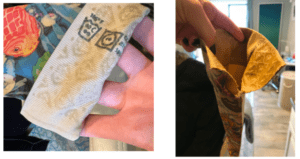

- It is hydrating and more delicate on the skin; however, it is not adaptable to swelling and other changes in patient’s body and not suitable for patients with aloe allergy.
- The silicone top of the sleeve is not as harsh in feel in comparison to other available products in the market, but can still cause discomfort to the patient.
- Existing fabrics are tight and inflexible, especially at the top portion under the armpit which is meant to prevent sliding.
- You can also see in the photo on the right that a patient the cut the fabric at the edge to make it easier for her to wear and because the pressure in that area was it was painful for her.
Coolomg ($15.99)
We bought Coolomg’s garment from Amazon since it was really inexpensive and at the same time the high-tech, athletic knit seemed appealing. The garment was definitely not comfortable. We ordered an XL size and it was not proportionate to any of our bodies. The inner side of the fabric also left an imprint on my arm after wearing it for a couple of hours. It seems it would prevent problems for anyone who wore it, regardless of their shape and size.
Circaid Circulation Glove ($116)
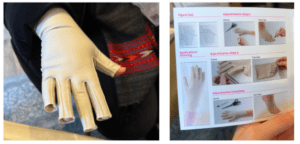
This is a glove we tried at Cynthia’s practice
- The circaid reduction kit glove is an ideal addition to a compression sleeve when patients experience hand and finger swelling.
- Trimmable fingers allow you to get a custom fit in terms of length for added comfort.
- However, the garment limited hand mobility and it seemed like it might be uncomfortable for long-term wear.
Chip Sleeve (starting $272)

- ChipSleeves contain open cell foam chips that provide a massaging effect on the superficial lymphatics.
- It provides massage and compression and helps soften fibrotic tissue and reduce swelling.
- We also tried this at Cynthia’s practice and according to her the soft nature of it is also ideal for sleep and the sleeve can act as a pillow.
Pharoah Sleeve (starting $200)
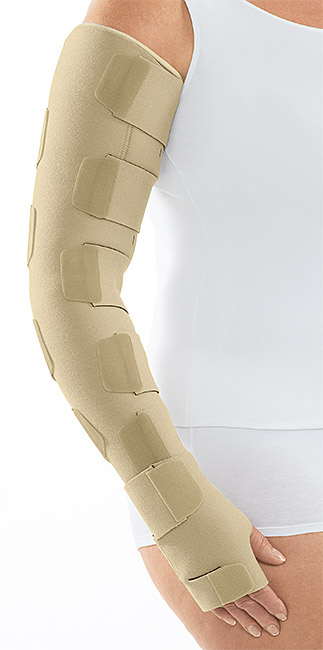
- This kit replaces traditional compression bandages, saving time and increasing the patients freedom and quality of life.
- The patient is able to easily remove and reapply allowing normal bathing and less intrusion on their everyday lives.
Kinesio Tape
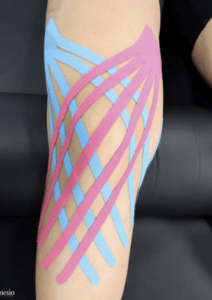
The above image shows latex-free and breathable cotton kinesiology tape, which is created to reduce inflammation and support muscles. SpiderTech’s Pre-Cut pieces are $6.99. It is also the most inexpensive solution for the patients.
In our preliminary research, we found that Kinesio Taping (KT) is effective in the management of lymphedema and can even improve limb functionality to a greater extent than compression garments in some cases.
However, after speaking with Cynthia about the technique, we learned that KT can damage the skin when not applied/removed properly. This poses risk for lymphedema patients.
Fabric Sample
Devices
Airos
AIROS Device AIROS device inflates
This is the AIROS 8-Chamber Compression garment. The chambers fill up sequentially to direct inflammation away from the affected hand and arm.
It comes in various sizes, is easy to use (since there are components to help the patient put it on independently), it is made from high-quality material, and is available with insurance. However, it is not cheap. The cost is $600 for the pump and $1450 with sleeve.
Normatec
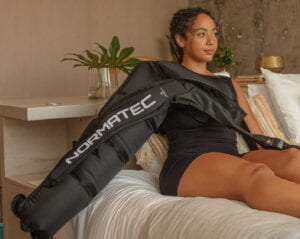
Normatec is a recovery suit that improves lactic acid distribution and muscle release after exertion using peristalic pulse compression. The suit actually does a muscle massage and relaxes them.
After speaking with Dr. Nadiv Shapira, we saw that some of the options for patients is suits like Normatec, it is used a lot for muscle therapy but Most of the Dr. Shapira patients is using this as a follow up treatment after their surgery.
The Chief Physiotherapist of the United States (Olympic and Paralympic) team Dr. Amber Donaldson said in an article that they use these suits regularly and the response from the athlete’s is very positive.
Koya
KoyaMedical has created prescription only, garment DaySpring. Dayspring is a programmable, calibrated, wearable active compression system designed to stimulate the body’s lymphatic system and claims to provide mobility and portability
Looking at the video we can see that although the garment provides portability but definitely not mobility. It also seems it can be uncomfortable if used for a long time and can hinder day to day activities.
Suggested Changes
Fabric
1. Raised Fabric Dots
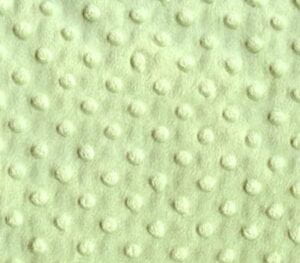
One of the suggestions we have is to make raised dots embedded within the fabric itself (while knitting) instead of applying the silicone after that is currently being used in industry products for grip in the forearm.
2. Rice Stitch with Flexible Yarns
Rice stitch
Some knitting techniques that we think can suit for the garment needs.
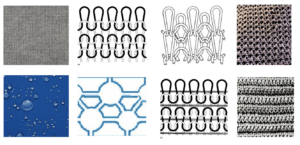
In the upper right picture it is the moss technique that can be very flexible but also strong and tight.
In the lower right it is the Rond which creates a folding the look like a plisse affect.
In the upper left side we have two sided fabric that the inside Layer will be made mostly from wool to make it nicer to the skin.
The lower left side is to apply resting waster material on the fabric to make it suitable for different body temperatures
Pattern
1. Over the shoulder garment
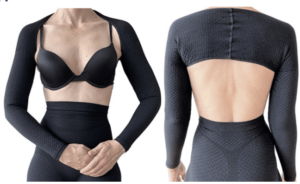
2. Pre-Cut Kinesio Taping with Stencil
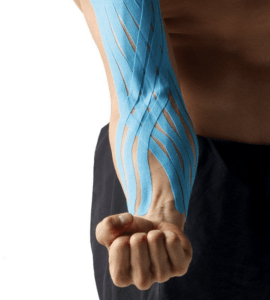
There are pre-cut kinesio tape available in market (SpiderTech)
maybe giving a stencil and instruction manual additionally with it might be helpful.
Learning Outcomes
As mentioned before, we realized that garments are not the only solution. Comprehensive care, from garments to massages and exercises, are the only lasting solutions for lymphedema patients. Importantly, Cynthia noted that care must adapt to the patient and their lifestyle, rather than forcing a patient into a care plan and garment that does not work for their experience or their body.
Future Partnerships
This is a recent development that we will feature in more detail in our upcoming blog, but we hope to facilitate collaboration between Tel Aviv University and Schecter Care for the continuation of this project, specifically as it pertains to smart fabrics for medical purposes.
They have a big knitting lab with all the technology and materials that can fit perfectly for this collaboration.
Future Goals
We hope to connect Cynthia to partners equipped with resources in textiles, smart fabrics, and connections to medical institutions for appropriate design, development, and testing of compression garments for lymphedema patients.
We suggest knitted garments COMBINED with smart structures that can fit perfectly without pressing and leaving marks and the use of materials that are flexible and sustainable.